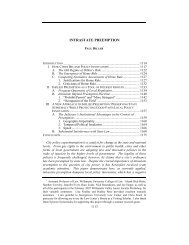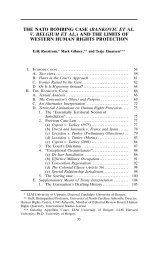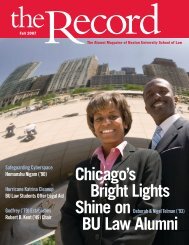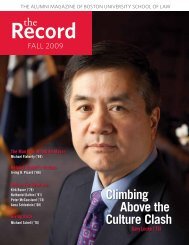the nature of representation: the cherokee right ... - Boston University
the nature of representation: the cherokee right ... - Boston University
the nature of representation: the cherokee right ... - Boston University
You also want an ePaper? Increase the reach of your titles
YUMPU automatically turns print PDFs into web optimized ePapers that Google loves.
2005] THE NATURE OF REPRESENTATION 93<br />
In order to realize <strong>the</strong> delegate <strong>right</strong>, <strong>the</strong> Cherokee nation must confront<br />
arguments that such a delegate <strong>right</strong> no longer exists, that it would not represent<br />
<strong>the</strong> ‘<strong>right</strong>’ groups, and that even if it is an existing <strong>right</strong>, its fulfillment would be<br />
unconstitutional. The Cherokee’s alliance with <strong>the</strong> Confederacy, delay in acting<br />
upon <strong>the</strong> delegate provision, and <strong>the</strong> partial dissolution <strong>of</strong> <strong>the</strong> Cherokee<br />
government a hundred years ago all support <strong>the</strong> argument that <strong>the</strong> Cherokee nation<br />
has lost <strong>the</strong> <strong>right</strong> to act upon <strong>the</strong> delegate provision. Politically, a Cherokee<br />
delegate would raise questions regarding <strong>the</strong> role <strong>of</strong> such a representative and <strong>of</strong><br />
who is being represented both within <strong>the</strong> Cherokee nation and across Indian<br />
country, questions likely accompanied by complaints from within and without <strong>the</strong><br />
Indian community. The strongest critique is that such a delegate would violate <strong>the</strong><br />
constitutional equal protections <strong>of</strong> non-Cherokees, who lacking <strong>the</strong>ir own group<br />
delegate would see <strong>the</strong> power <strong>of</strong> <strong>the</strong>ir vote diminished relative to <strong>the</strong> super-vote <strong>of</strong><br />
<strong>the</strong> Cherokees.<br />
While criticisms <strong>of</strong> <strong>the</strong> Cherokee delegate reveal <strong>the</strong> provision’s current<br />
complexities, <strong>the</strong>se criticisms ignore <strong>the</strong> existing link between <strong>the</strong> delegate <strong>right</strong><br />
and <strong>the</strong> advantages and land use still enjoyed by non-Cherokees as a result <strong>of</strong> <strong>the</strong><br />
Treaty’s main purpose <strong>of</strong> removal. Comparing <strong>the</strong> Cherokee delegate provision<br />
both to earlier, lesser Indian treaty promises and to current non-voting delegate<br />
allowances permits <strong>the</strong> delegate to be seen more favorably, even by non-Cherokees.<br />
Though <strong>the</strong> Supreme Court is hesitant to recognize group <strong>right</strong>s, <strong>the</strong> recognition <strong>of</strong><br />
an Indian nation’s <strong>right</strong> to participation in <strong>the</strong> U.S. government in consideration<br />
for what that nation has given up might not succumb to group based constitutional<br />
challenges. Finally, even with <strong>the</strong> possibility that through Court decision or<br />
Congressional plenary power <strong>the</strong> delegate might be disallowed or not recognized, a<br />
push for a Cherokee delegate should not be abandoned. The denial <strong>of</strong> a Cherokee<br />
delegate ought to be accepted only if <strong>the</strong> Cherokees are provided additional<br />
payment or o<strong>the</strong>r consideration on an equitable basis to <strong>of</strong>fset that denial.<br />
II. ROAD TO NEW ECHOTA<br />
To understand <strong>the</strong> delegate <strong>right</strong>, Cherokee removal and <strong>the</strong> disputes regarding<br />
<strong>the</strong> removal must be understood. By <strong>the</strong> time Andrew Jackson became President<br />
in 1829, <strong>the</strong> forcing <strong>of</strong> Indians beyond <strong>the</strong> territorial boundaries <strong>of</strong> <strong>the</strong> existing<br />
states, termed “removal,” was considered a possible ‘solution’ to <strong>the</strong> Indian<br />
problem. Looking back on Indian removal almost two centuries later, it is<br />
tempting to characterize <strong>the</strong> removal as an unfortunate part <strong>of</strong> our history, but not <strong>of</strong><br />
particular relevance today. 3 But even in <strong>the</strong> 1830s, removal seemed to undermine<br />
3<br />
Removal is frequently described as “inevitable,” and <strong>the</strong>refore implicitly not<br />
controversial. ARTHUR MEIER SCHLISINGER, POLITICAL AND SOCIAL HISTORY OF THE UNITED<br />
STATES 1829-1925, at 27 (1920). A partial explanation for <strong>the</strong> tendency to relegate<br />
removal to a bygone era (while those following <strong>Boston</strong>’s FreedomTrailfeel<strong>the</strong> past is<br />
more present) can perhaps be found in a telling sentence introducing a book on removal:<br />
“Nations, like men, are sometimes interested in burying <strong>the</strong> past.” Richard E.









